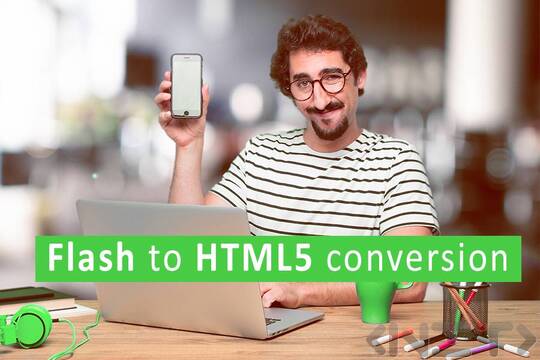
Approximate reading time: 3m 57s
Not everything is on fire, you can save your courses by converting them from Flash to HTML5 - with the right tools and a partner it is way easier than it sounds.
Why?
Adobe Flash Player has been a big part of the multimedia industry but it has done its purpose. With modernization and technical growth, most of the big companies are stopping Flash’s support. It was all decided when Steve Jobs stopped supporting it on any of the iOS devices. Browsers followed his lead and the majority of them have already blocked Flash’s output.
Once used for developing and delivering an eLearning, Flash has its flaws and limitations - plugins, security issues, and battery drainage of your device. But there are new rising stars with more convenient usage and more advantages - The authoring tools, one of the reasons converting from Adobe Flash to HTML5 becomes a must.
Do I have to convert Flash to HTML5?
Don’t let the old tools hold you back, make adjustments when needed. In the case of Flash, that means - collect the source files of the courses you wish to keep and convert them to HTML5. That’s how you’ll keep the relevant eLearning you have even sharper.
Major benefits of the conversion also are:
- Making them mobile-friendly hence it’ll ensure accessibility for your learners anytime, anywhere.
- Updating and Refining your course. By collecting the needed source files for converting you are able to go through them again with ‘new eyes’ and add or remove the necessary.
- The authoring tools running on HTML5 are more adaptive to the learner’s needs which means you have more room for better interactions, designs, and graphics.
- Lengthy modules can become microlearning - small chunks of knowledge up to 3 min read is the match made in heaven.
How to do the conversion from Adobe Flash to HTML5?
So you made your mind and you are ready for the change, now what? We got your back! There are 4 strategies for you to do so. Also known as the 4 ‘R’s:
- Record Flash courses without source files and with low-level interactivities. Those recalling basic MP4 format.
- Republish the course (if you still have the source files) in the newer version of the authoring tool you’ve used in the first place.
- Rebuild the course with another tool if the original one doesn’t support HTML5. Reuse the assets if they are still relevant.
- Redesign if there are legacy courses that need updates, or there are no longer relevant parts. (Yes, jokes get old.)
It’s time to decide which strategy to convert Flash to HTML5 you’ll use, here’s a six-step guide to help you.
1. Revise your Flash courses. Are they relevant and current?
2. If yes, check if you have the source files for them.
3.a. If you don’t have the files, and the course is straightforward and easy to understand, choose the ‘Record’ strategy.
3.b. If you don’t have the source files and the courses have relevant media elements - ‘Rebuild’ is the way to go.
4. If you have the source files and the authoring tool you build it on is up to date, choose the ‘Republish’ conversion strategy.
5. If your Flash course is still relevant and current, but it needs minor content updates, then go with the ‘Rebuild’ strategy.
6. When there should happen major changes - instructional design, content updates, or fitting into microlearning - choose the ‘Redesign’ conversion strategy.
Project management for converting Flash to HTML5
The conversion of Flash-based courses is a big project. For it to be successful one must have a good plan and a greater prioritization system not only for the Flash to HTML5 conversion but for the people who will work on it, all risks and opportunities too.
We would like to present to you a 9-step process that gives a bird’s eye view of converting Flash to HTML5.
Phase 1
Step 1 - Collect the source files of the courses you want to convert.
Step 2 - Extract the relevant content and media elements, store them in a proper folder structure.
Step 3 - Choose the right for your needs authoring tool for your Flash to HTML5 conversion.
Step 4 - Decide on the user interface and interactions you’ll use in the new courses.
Step 5 - Select a template for quick development and assessment of the previous steps.
Phase 2
Step 6 - Develop a prototype - you can make one for each conversion strategy.
Step 7 - Share the results with your stakeholders - get their approval.
Phase 3
Step 8 - Develop the final version of the courses, publish them according to the selected conversion strategy.
Step 9 - Revise your converted HTML5 courses on multiple devices and browsers before you give them to the learners.
It may seem an easy task, but if you want a well-designed and developed eLearning course, you need to deal with many obstacles. Our team of experienced instructional designers and eLearning developers can help you during the process.
Flash to HTML5 conversion services
1. Refining and designing the course in accordance with HTML5. This means all buttons, links, tabs, and instructions will fit seamlessly and with greater interaction even on mobile devices.
2. Reconstruction of the course according to the Flash to HTML5 conversion - meaning, reconsidering together the course structure and how it can be transformed suiting the new needs. With the millennials ‘on the market’ we recommend sizing down the content into smaller, logical portions, so they won’t be overwhelmed by it.
3. Choosing the right authoring tool with an expert in the field. We’ll help with the decision on which tool will meet your eLearning needs - Articulate Storyline, Captivate, Adapt and many more.
4. Will give you a new responsive design of your course - everything converted from Flash to HTML5 needs a new fresh look for the bright future to come.



